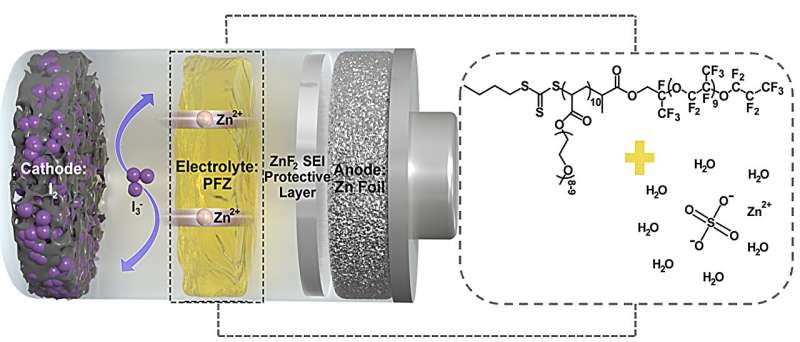This article has been reviewed according to Science X's editorial process and policies. Editors have highlighted the following attributes while ensuring the content's credibility:
fact-checked
proofread
Beyond lithium: New solid state ZnI₂ battery design opens doors for sustainable energy storage

Rechargeable aqueous zinc-iodine batteries get a lot of attention because they are safe, do not cost much, and have a high theoretical capacity. Zinc has a high theoretical capacity (820 mAh g-1) and iodine is found in large amounts in the Earth's crust. However, the limited cycle life of zinc-iodine batteries remains a significant challenge for their market viability.
The thermodynamic instability of the zinc electrode in an aqueous electrolyte always leads to the release of hydrogen, which causes the battery to swell and eventually fail. In addition, in aqueous electrolytes, reversible redox reactions often occur at the iodine cathode, involving triiodide, iodide, and polyiodide (I3-/I-/I5-). The ZnO and Zn(OH)42- passivation layers may further interact with triiodide and exacerbate the adverse effects on the zinc anode. Therefore, mitigating these parasitic side reactions on the zinc surface is essential to achieve a long-life rechargeable ZnI2 battery.
The researchers reported a new class of fluorinated block copolymers as solid electrolytes for the development of all-solid-state ZnI2 batteries with extended lifespan. The results of the study suggest that the zinc metal anode circulating in this solid electrolyte forms a stable fluoride-rich SEI layer, which promotes the deposition of zinc in the horizontal direction and prevents the growth of harmful zinc dendrites that can damage the separator and cause battery failure.
In addition, this solid electrolyte effectively relieves the I3- shuttle problem extending the battery lifetime. Symmetrical cells assembled with this solid electrolyte are stably plated and stripped for about 5,000 hours at 0.2 mA cm-2. The complete ZnI2 battery has a longer rating of 0.5 C, impressive rate performance, and nearly 100% coulombic efficiency for more than 7,000 cycles (over 10,000 hours). The electrolyte exhibits excellent rate performance, delivering a reversible capacity of 79.8 mAh g-1 even at ultra-high current densities of 20 C.
These results highlight the great commercial potential of this all-solid-state battery. This study opens a new avenue for the design of fluorosolid-state polymer electrolytes for next-generation ZnI2 batteries with dendricity-free Zn metal anodes and ultra-long battery life.
Future research will explore more practical application scenarios of this battery while controlling costs. This solid-state ZnI2 battery featuring the solid perfluoropolyether (PFPE)-based polymer electrolyte demonstrates the formation of a solid electrolyte interphase (SEI) layer on zinc, promoting horizontal zinc growth, mitigating dendrite penetration, and enhancing battery cycle life.
Moreover, the solid electrolyte hinders the iodine ion shuttle effect, reducing zinc foil corrosion. Symmetric batteries employing this electrolyte demonstrate excellent cycle performance, maintaining stability for approximately 5,000 hours at room temperature, while solid-state ZnI2 batteries exhibit over 7,000 cycles with a capacity retention exceeding 72.2%.
This work offers a promising pathway to achieving reliable energy storage in solid-state ZnI2 batteries and introduces innovative concepts for flexible and wearable zinc batteries.
The research is published in the journal Materials Futures.
More information: Yongxin Huang et al, Enhancing Performance and Longevity of Solid-State Zinc-Iodine Batteries with Fluorine-Rich Solid Electrolyte Interphase, Materials Futures (2024). DOI: 10.1088/2752-5724/ad50f1


















